Common Name
Microlophus peruvianus
Scientific Name
Microlophus peruvianus
Habitat
Microlophus peruvianus, commonly known as the Peruvian lizard, primarily inhabits the coastal regions of Peru, specifically within the diverse ecosystems of marine habitats and adjacent local hinterlands. These lizards are often found in arid and semi-arid environments, characterized by low-lying, rocky areas. The climate of their habitat ranges from dry desert-like conditions to more temperate influences brought in from the Pacific Ocean, which contributes to the formation of various unique microhabitats. Within these ecosystems, Microlophus peruvianus is found among grasslands and sparse shrublands that can often border on coastal savannas, showcasing a remarkable adaptability to different environmental conditions.
Physical Characteristics
Measuring approximately 15 to 25 centimeters in length, Microlophus peruvianus displays a distinct and compact body structure that is well-suited for its rocky terrain. Its skin color varies significantly, ranging from a vibrant green or brown to more muted gray tones, providing effective camouflage against its natural habitat. The lizard’s skin is covered in small, granular scales that add to its protection and help retain moisture. A particularly notable feature is its long, slender tail, which can be almost twice the length of its body. This adaptation aids in balance and agility, allowing Microlophus peruvianus to navigate uneven and rugged surfaces with ease.
Behavior
Behaviorally, Microlophus peruvianus is primarily diurnal, meaning it is most active during the day. These lizards tend to be territorial, often found basking on rocks or sunlit surfaces to regulate their body temperature. Social interactions among individuals can be observed during the breeding season, where males establish dominance through displays of strength and color vibrancy. Notably, Microlophus peruvianus exhibits unique fleeing mechanisms when threatened, using both rapid sprinting and the ability to seamlessly blend into rocky surroundings, which serve as effective escape strategies from predators. Additionally, they have developed interesting mating rituals that involve elaborate courtship displays, including rearing and body movements, enhancing their reproductive success.
Diet
The dietary habits of Microlophus peruvianus are predominantly insectivorous, though they may also consume a variety of small invertebrates. Their primary food sources include ants, beetles, and other small arthropods, making them important contributors to controlling insect populations. The hunting techniques of these lizards involve keen eyesight paired with swift movements, which allows them to efficiently capture prey. While they mainly thrive on animal matter, their diet is occasionally supplemented with plant material, linking them to herbivorous feeding patterns when the opportunity arises in their natural habitat.
Reproduction
Microlophus peruvianus follows a specific reproductive cycle that occurs typically from late spring to early summer. Mating involves an elaborate courtship display, after which females lay clutches of 4 to 10 eggs in hidden burrows or among rocky crevices to protect them from predators. The incubation period generally lasts about 60 to 70 days, with hatchlings emerging during warmer months. After hatching, young lizards are relatively independent but remain vulnerable to predators. Parental care in Microlophus peruvianus is minimal, as the focus of adults shifts toward their individual survival and territorial defense.
Conservation Status
Currently, the conservation status of Microlophus peruvianus is classified as Least Concern according to the International Union for Conservation of Nature (IUCN). However, habitat destruction due to urbanization, agricultural expansion, and climate change poses significant threats to their populations. Conservation efforts targeting the protection of their natural habitats are crucial to ensure their continued survival. Although not considered endangered, ongoing monitoring and environmental awareness campaigns are essential to mitigate potential future risks.
Interesting Facts
One of the most intriguing aspects of Microlophus peruvianus is its ability to change color subtly, aiding in camouflage and temperature regulation. Additionally, these lizards possess impressive climbing abilities, allowing them to navigate their rocky habitats efficiently. Their adaptability to varying environmental conditions is a testament to their resilience, making them a subject of interest for researchers studying evolutionary biology and ecological dynamics.
Role in Ecosystem
Microlophus peruvianus plays a significant role in its ecosystem as both a predator and prey species. By controlling insect populations, they contribute to maintaining ecological balance while serving as a food source for larger predators such as birds of prey and small mammals. Furthermore, their burrowing behaviors help aerate the soil, promoting the health of the overall habitat. This lizard exemplifies the intricate interconnections within ecosystems, emphasizing the need to understand and protect such species to maintain biodiversity.
